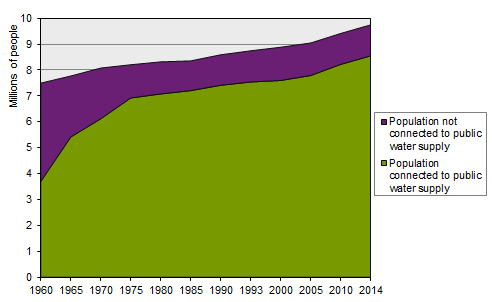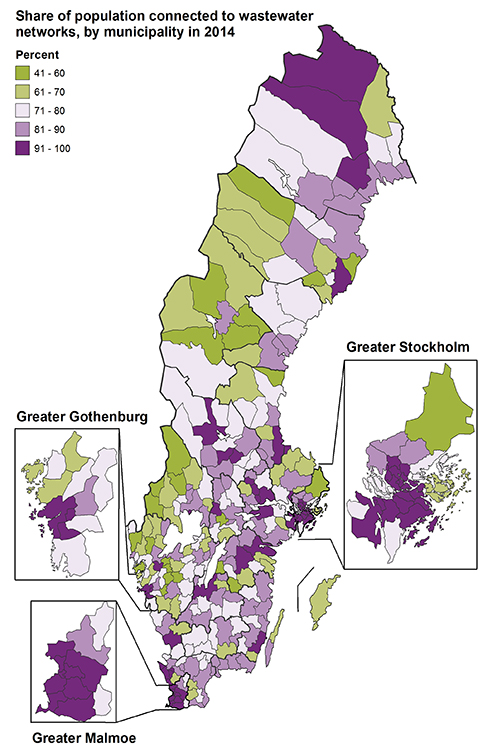Water withdrawal and water use in Sweden:
Almost 9 out of 10 people are connected to public water and wastewater networks
Statistical news from Statistics Sweden 2016-06-23 9.30
About 87 percent of the total resident population in Sweden is connected to public water and wastewater networks according to new figures from Statistics Sweden. For the first time, statistics regarding water and wastewater services have been released as official statistics.
Public water and wastewater services were introduced in the largest Swedish cities during the second half of the nineteenth century. The main driver for investing in fresh water and sanitary services was to improve public health. The fresh water networks provided clean drinking water to the urban population and wastewater could be safely removed from the urban environment through the underground sewer system. The development of the networks helped to lessen the spread of disease.
Rapid development during the 1960s and 70s
But it was not until the 1950s and 1960s that large scale development arrangements for water and wastewater services were put in place. During this period, the public infrastructure for water and sanitary services was extended to also cover smaller urban settlements. In 1960, roughly half of the resident population in Sweden was connected to public water and wastewater networks. Only ten years later, the proportion had increased to 75 percent. In the beginning of the 1980s, the pace of development slowed down considerably, and from the 1980s and onwards, the share of population connected to the public networks has increased only marginally.

Sources: VAV 1960–1995, Swedish Water & Wastewater Association, The Real Estate Tax Assessment Register 2000–2015, the Total Population Register 2000–2014, SCB.
Share of connected population varies among municipalities
At the national level, some 87 percent of the total resident population is connected to public networks. However, the proportion varies considerably in different parts of the country. In larger, more densely populated metropolitan municipalities, the proportion is more or less hundred percent, whereas in large but sparsely populated rural municipalities, the share is much lower. However, only in four of 290 municipalities is the share of population connected to public networks below 50 percent.

Sources: The Real Estate Tax Assessment Register 2015 and the Total Population Register 2014, Statistics Sweden.
Some 690 000 individual sewage disposal systems
In total there are some 690 000 one- or two dwelling buildings with individual sewage disposal systems in Sweden. One third of these buildings are holiday homes mainly used for seasonal dwelling. Another quarter of a million of one- or two dwelling buildings do not have sewage disposal systems at all. Almost 90 percent of them comprise holiday homes.
Typically, a one- or two dwelling building connected to public water is also equipped with public wastewater collection. However, the number of one- or two dwelling buildings with public water slightly exceeds the number of buildings with public wastewater collection.
Extensive data in the Statistical Database
The statistics comprise data on water and wastewater services in one- or two dwelling buildings, categorised by permanently dwelled buildings and holiday homes for seasonal use. Data on population by type of water and wastewater connection is also presented. All figures are disseminated as aggregations for the country as well as by regional breakdown, such as county, river basin districts and municipalities.
Data is presented for the latest available year 2014, as well as for five year intervals back to the year 2000. A long time series for the whole country is also presented regarding the share of the population connected to water and wastewater services from 1960 to 2014.
Definitions and explanations
The main source for the statistics on water and wastewater services is the Real Estate Tax Assessment Register. Owners of one- or two dwelling buildings are obliged to provide information to the Swedish Tax Agency regarding the type of water and wastewater connection. The information is used by the Swedish Tax Agency to make a proper assessment of the value of a property.
In order to disaggregate the population by type of water and wastewater connection, the Real Estate Tax Assessment Register has been joined with the Total Population Register on the basis of address location.
As owners of multi-dwelling buildings are not obliged to provide information to the Swedish Tax Agency about the type of water and wastewater connection, the resident population living in multi-dwelling buildings cannot be assigned to a type of connection on the basis of the information from the Real Estate Tax Assessment Register. However, it is assumed that all multi-dwelling buildings are connected to public networks. Consequently, the population living in such dwellings are considered to be connected to public services for water and wastewater.
Feel free to use the facts from this statistical news but remember to state Source: Statistics Sweden.
